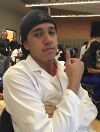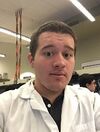BME100 f2015:Group14 1030amL6
| Home People Lab Write-Up 1 | Lab Write-Up 2 | Lab Write-Up 3 Lab Write-Up 4 | Lab Write-Up 5 | Lab Write-Up 6 Course Logistics For Instructors Photos Wiki Editing Help | |||||||
|
DYNAMIC DIAGNOSTICS INC
LAB 6 WRITE-UPBayesian StatisticsOverview of the Original Diagnosis System BME100 was divided into 17 different groups to determine whether or not 34 patients were positive for a specific SNP disease. PCR would use the DNA from an individual and compare it to known controls, and then amplify the diseased strands enough to be detectable by diagnostic equipment. In order to reduce error, all groups minimum human error by using a select group of people for the PCR. For example, when it came to the flourimeter testing, people were divided up for tasks: one person was responsible for PCR pipetting, another was in charge of keeping of the PCR solutions, another was responsible for taking photos, another for imageJ analysis, etc. Onto the testing itself: The PCR reaction would be inserted into a fluorimeter, which would test for the fluorescence of each and every sample, and compare it to a known calibration of controls and calf thymus DNA. This was done through the quantifying the data from the fluorimeter images through the program imageJ to measure the darkness values of individual pixels. Unfortunately, the data analysis came up with an unsatisfactory amount of errors such as false positives and negatives, which is why data was then ran through Bayes Statistics. In a nutshell, while more often correct than not, Bayes statistics revealed an inherent unreliability in the PCR reaction.
Calculations 1 were done in order to gauge the relationship between a positive test conclusion given a positive PCR reaction. Nearly 4/5th of the time, the PCR reaction was successful at this. Calculation 2 gives us the opposite, the relationship between a negative conclusion and a negative PCR reaction, thankfully, this was also more often correct than not. Jointly, both these calculations are useful for determining the reliability of the PCR reaction.
Intro to Computer-Aided DesignTinkerCAD The TinkerCAD tool is a 3D project program that allows the user to model designs for objects and possibly print them. We used the TinkerCAD tool to design an improved model of the fluorimeter that we used in the previous wet labs.TinkerCAD is more simple than Solid Works; however, the options for modeling are limited compared to Solid Works, which allows for a better spatial understanding of the model and the ability to put different parts into an assembly. That being said, TinkerCAD is more user friendly.
Our Design
Our improved design for the fluorimeter involves the way the droplet is imaged. Instead of using the conventional stand that is placed at the optimal distance from the droplet (7 cm), we have attached the stand to the fluorimeter itself to ensure that it will remain at the optimal distance from the droplet at all times. In addition, there is a fitted hole in the stand that a Go-Pro with a self-stick attachment will be placed in. The camera will thus always remain at the optimal distance from the droplet, but the attachment to the selfie stick will allow for the user to change the angle at which the photo is taken to ensure optimal quality of the image. This method will also allow for less chance of light entering the fluorimeter chamber.
Feature 1: ConsumablesAs our fluorimeter device still assists by capturing photos of droplets just like the current fluorimeter device, the distance error between the camera of a chosen smartphone relative to the droplet will be eliminated with the fluorimeter device. As for the consumables included within our device they remain unchanged. What's included is: the pipettor, along with its separate pipette tips, and a pipettor stand, empty PCR test tubes, PCR test tubes with the reactants, and lastly the sample tubes of DNA. The fluorimeter device's consumables include:
Feature 2: Hardware - PCR Machine & FluorimeterThe fluorimeter will be included in our system as the main product because it is being improved to the greatest extent. We are creating new attachments to improve imaging of the results from the fluorimeter. We will also include the Open PCR machine (although it is not being improved to the extent of the fluorimeter). The Open PCR machine is being improved in terms of user-friendliness. The improved Fluorimeter will have a stand attached to the front of the main machine. This stand will have a groove on which a Go-Pro will be situated. The Go Pro will be attached to a selfie stick which will be manipulated by the user. This will allow for both optimal distance from the droplet (because the stand will not be accidentally moved any longer) and the ability to manipulate the angle of the camera. The improvement to the Open PCR machine is that a new LED panel will be installed on top of the machine which will allow for more options in running the program. This improvement is following the observation that there really were not many options in parameters for the PCR program.
| |||||||





